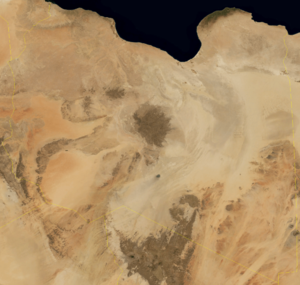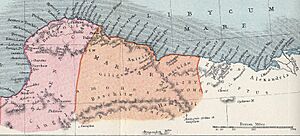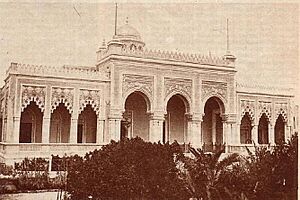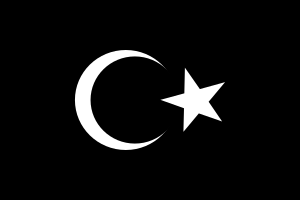Cyrenaica facts for kids
Quick facts for kids
Cyrenaica
برقة
|
|
|---|---|
|
Region
|
|

The traditional region of Cyrenaica (dark green), and the modern expansion (light green)
|
|
| Country | |
| Government | |
| • Type |
|
Cyrenaica (pronounced SY-rə-NAY-ik-ə or SIRR-ə-NAY-ik-ə) is a large region in the eastern part of Libya. It stretches from the 16th to the 25th lines of longitude (imaginary lines on a map). In ancient times, the coastal part of Cyrenaica was known as Pentapolis, meaning "Five Cities."
Cyrenaica became a colony of Italy in 1911. Later, it was one of the three main regions of Italian Libya. After World War II, the British managed the area until 1951. Then, it became part of the Kingdom of Libya. Today, Cyrenaica is divided into several smaller administrative areas. The 2011 Libyan Civil War began in this region.
Contents
Discovering Cyrenaica
Cyrenaica sits on a huge block of limestone. This land tilts up from the Mediterranean Sea and then slopes down towards the desert.
The region has two main parts. The Jebel Akhdar, or "Green Mountain," runs along the coast. It reaches a height of 882 meters (about 2,894 feet). There isn't a long, flat coastal area, except for a strip near Benghazi.
A steep cliff separates the coast from a flat area called the Marj Plain. This plain is about 300 meters (984 feet) high. Above it is another plateau, about 700 meters (2,297 feet) high, where the highest peaks are found.
Land and Nature
The Jebel Akhdar area has a Mediterranean climate. This means it has hot, dry summers and mild, rainy winters. You can find forests, woodlands, and different types of shrublands here.
Some common plants include juniper, pistachio, oak, and carob trees. The upper plateau has forests with cypress, olive, and Aleppo pine trees.
The Marj Plain has rich red soil, perfect for growing wheat and barley. Many springs flow from the highlands. Wild olive trees are common, and large areas of oak provide food for the local Bedouins' animals. Sadly, the forested areas have been shrinking over the past few decades.
South of the Jebel Akhdar, the land becomes much drier. This eastern part was called Marmarica in ancient times. Here, the Sahara Desert reaches the coast. Historically, people here focused on collecting salt and fishing for sponges more than farming.
South of the coastal highlands is a vast desert area called the Libyan Desert. It includes huge sand seas. This desert is home to a few oases, like Awjila and Jaghbub, where water can be found.
A Look Back in Time
Early People of Cyrenaica
The earliest known people to live in Cyrenaica were the Berbers. Ancient Egyptian records from around the 13th century BC mention that tribes from Cyrenaica often entered Egypt.
Ancient Greeks Arrive

The Greeks began settling in Cyrenaica around 631 BC. They called the region Kyrenaïka. The most important Greek city was Cyrene. It was founded by people from the Greek island of Thera who were looking for a new home due to a severe famine.
The western part of the region became known as the Pentapolis, or "Five Cities." These were Cyrene (with its port Apollonia), Taucheira, Euesperides (near modern Benghazi), Balagrae (Bayda), and Barce (Marj). Cyrene was the main city.
This region was very fertile. It produced barley, wheat, olive oil, wine, and figs. It was also famous for a special herb called silphium, which only grew there. It was used as medicine and for other purposes.
Cyrene became a major center for learning and art in the Greek world. It had a famous medical school and beautiful buildings. A group of thinkers called the Cyrenaics believed that happiness came from enjoying life's pleasures. Famous people from Cyrene include the poet Callimachus and the mathematicians Theodorus and Eratosthenes.
Persian and Hellenistic Rule
In 525 BC, the Persian army took control of the Pentapolis. They ruled the area for about 200 years.
Later, Alexander the Great arrived in 332 BC. After he conquered Egypt, the cities of Cyrenaica paid tribute to him. The region then became part of the kingdom ruled by Ptolemy I Soter and his family, known as the Ptolemaic dynasty.
Roman Times
The name Cyrenaica comes from the first century BC, when the Roman Republic took control. By 78 BC, it was combined with Crete to form one Roman province.
Around 293 AD, the Roman Empire changed how Cyrenaica was governed. It was split into two provinces: Libya Superior (or Libya Pentapolis) and Libya Inferior (or Libya Sicca). Each had its own governor.
After the Roman Empire split, Cyrenaica became part of the East Roman Empire, also known as the Byzantine Empire.
Under Arab and Ottoman Rule
Muslim Arabs conquered Cyrenaica around 642 AD. The region then became known as Barqah, named after the ancient city of Barce. For a long time, it was connected to Egypt.
In the 11th century, Arab tribes, including the Banu Hilal, moved into North Africa. This led to Cyrenaica becoming more Arab than almost any other place outside of Arabia. Later, the Ottoman Empire took control of Cyrenaica, making it part of Ottoman Libya.
In 1879, Cyrenaica became a special region within the Ottoman Empire. It was divided into smaller areas.
Italian Control

Italy took over Cyrenaica during the Italo-Turkish War in 1911. They declared it an Italian protectorate (a territory protected and partly controlled by a stronger power). In 1912, the Ottoman Empire officially gave the province to Italy.
In 1919, Cyrenaica became an Italian colony. The Italian government recognized Sheikh Sidi Idriss as the leader of the Senussi people, giving him the title of Emir (a princely rank).
On January 1, 1934, Cyrenaica was joined with Tripolitania and Fezzan to form the Italian colony of Libya. The Italians built a large Marble Arch at the border between Cyrenaica and Tripolitania.
During World War II, there was heavy fighting in Cyrenaica. In late 1942, Allied forces took control from the Italian and German armies. The United Kingdom managed most of Libya until 1951.
Becoming Independent
In 1949, Idris al-Senussi, with support from the British, declared Cyrenaica an independent emirate. This emirate then became part of the Kingdom of Libya when it was formed. On December 24, 1951, Libya became an independent kingdom, and Idris al-Senussi became King Idris.
Cyrenaica Today
In 1969, Colonel Muammar Gaddafi took power, ending the Senussi dynasty. Cyrenaica sometimes saw opposition to Gaddafi's government.
In 2007, a plan was announced to help Cyrenaica grow. This plan aimed to improve farming, create a national park, and develop the region for cultural and eco-tourism (tourism focused on nature). It included plans for new hotels.
During the 2011 Libyan Civil War, Cyrenaica was mostly controlled by the National Transitional Council. While some suggested Cyrenaica become a separate state, this idea was rejected. The three regions of Libya were reunited in October 2011 after the government changed.
See also
- Cyrenaics philosophical school
- List of kings of Cyrene
- List of colonial heads of Cyrenaica
- Mediterranean dry woodlands and steppe
- History of Libya
- Christianity in Libya
- Islam in Libya
Images for kids






